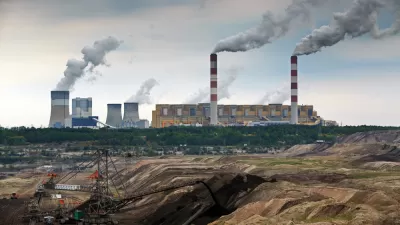According to a newly released report by the Paris-based International Energy Association (IEA), "Tracking Clean Energy Progress 2013", notwithstanding some bright spots, there is little progress in reducing the carbon content of energy sources.
Ben German provides the depressing account of the state of world energy provided by the new report released April 17 at the fourth Clean Energy Ministerial taking place in New Delhi, India. The lack of progress can largely be placed on the increased use of coal throughout much of the world.
“Despite much talk by world leaders, and despite a boom in renewable energy over the last decade, the average unit of energy produced today is basically as dirty as it was 20 years ago,” IEA Executive Director Maria van der Hoeven said on April 17.
From IEA's press release: "To illustrate this inertia, the report, Tracking Clean Energy Progress, introduces the Energy Sector Carbon Intensity Index (ESCII), which shows how much carbon dioxide is emitted, on average, to provide a given unit of energy. The ESCII stood at 2.39 tonnes of CO2 per tonne of oil equivalent (tCO2/toe) in 1990, and had barely moved by 2010, holding at 2.37 tCO2/toe."
German note's two bright spots: "Green energy development has increased sharply worldwide, and in the U.S., the world’s second-largest greenhouse gas-emitter (after China), growth in natural gas-fired power at coal’s expense has helped curb carbon emissions."
In Europe, on the other had, greenhouse gas emissions rose due to increased consumption of coal (in part due to Germany's reduction of nuclear power and the higher price of natural gas compared to the U.S.).
Neela Banerjee of the Los Angeles Times wrote about the 1.6% decline in greenhouse gas emissions from 2010 to 2011 reported by the Environmental Protection Agency.
The decrease continued an overall decline in U.S. greenhouse gas emissions, down 6.9% since 2005. The EPA said the drop from 2010 to 2011 is driven mostly by power plants switching from coal to natural gas, which emits less carbon dioxide when burned.
Correspondent's note: The IEA website, http://www.iea.org/, was having difficulty on April 18 - perhaps on account of too many hits to access the Tracking Clean Energy Progress report.
FULL STORY: International Energy Agency: Progress toward low-carbon energy ‘stalled’

Alabama: Trump Terminates Settlements for Black Communities Harmed By Raw Sewage
Trump deemed the landmark civil rights agreement “illegal DEI and environmental justice policy.”

Study: Maui’s Plan to Convert Vacation Rentals to Long-Term Housing Could Cause Nearly $1 Billion Economic Loss
The plan would reduce visitor accommodation by 25% resulting in 1,900 jobs lost.

Planetizen Federal Action Tracker
A weekly monitor of how Trump’s orders and actions are impacting planners and planning in America.

Wind Energy on the Rise Despite Federal Policy Reversal
The Trump administration is revoking federal support for renewable energy, but demand for new projects continues unabated.

Passengers Flock to Caltrain After Electrification
The new electric trains are running faster and more reliably, leading to strong ridership growth on the Bay Area rail system.

Texas Churches Rally Behind ‘Yes in God’s Back Yard’ Legislation
Religious leaders want the state to reduce zoning regulations to streamline leasing church-owned land to housing developers.
Urban Design for Planners 1: Software Tools
This six-course series explores essential urban design concepts using open source software and equips planners with the tools they need to participate fully in the urban design process.
Planning for Universal Design
Learn the tools for implementing Universal Design in planning regulations.
Caltrans
Smith Gee Studio
Institute for Housing and Urban Development Studies (IHS)
City of Grandview
Harvard GSD Executive Education
Toledo-Lucas County Plan Commissions
Salt Lake City
NYU Wagner Graduate School of Public Service





























